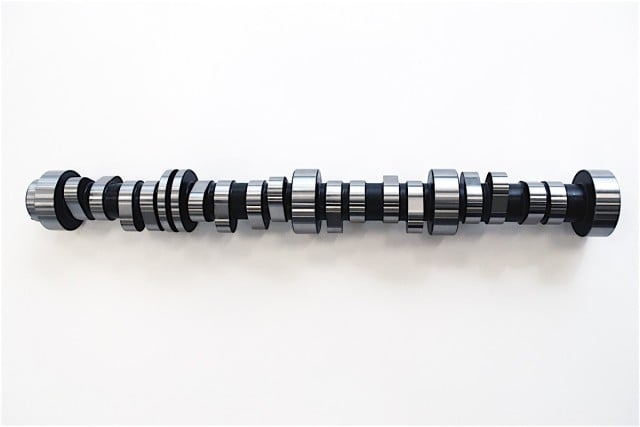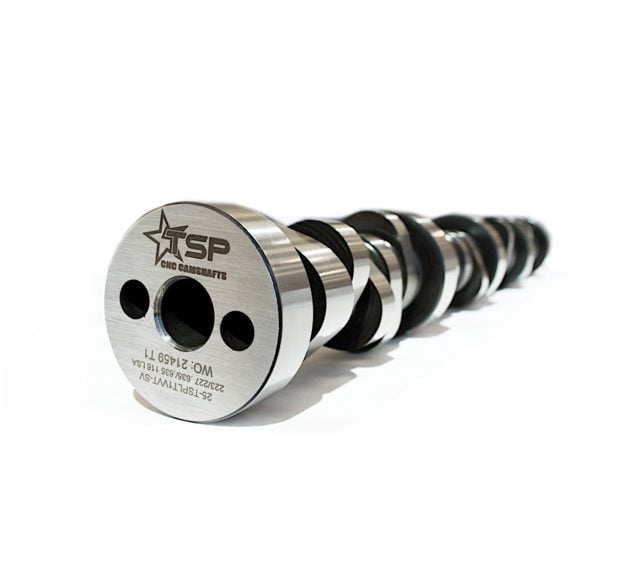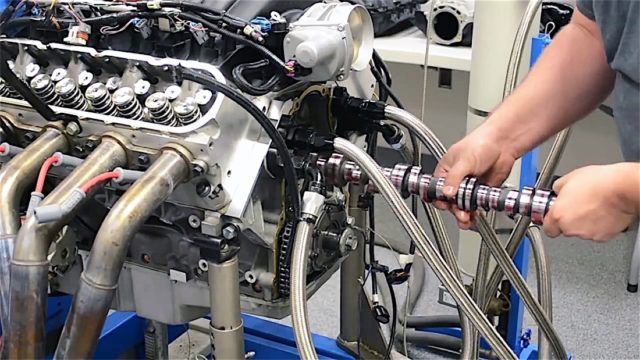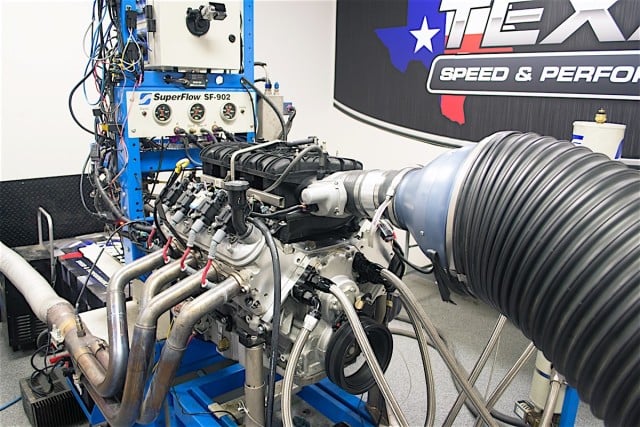When it comes to the fifth-gen Camaro, the LS3 reigns king, relegating the L99 to the limelight. And while we’d love to tell you differently, we are just as guilty as anyone of favoring the crowd-pleasing LS3 in the past. Since the LS3 is one of the most popular platforms in LS history, and possibly automotive history as well, it’s easy to overlook its twin brother—even if it is actually more technologically advanced than the former. However, we are here to tell you that overlooking the L99 was a mistake. And it’s a mistake that we are hell-bent on correcting, especially since more than half of all fifth-gen Camaros are L99-powered.
And while we may have been found guilty of neglecting the capable L99, our friends over at Texas Speed & Performance [2] (TSP) have always known what a potent performer it can be. That’s why they’ve doubled down on the platform with their new line of variable valve timing camshafts. These bumpsticks have the L99 producing power like you wouldn’t believe.
 [3]But before we get into just how much power Texas Speed’s new cams could net you, let’s talk about their new and improved test facilities. Texas Speed has been a leader in the LS world for as long as we can remember. From their Torquer line of cams to the infamous Magic Stick grinds, TSP has been producing some of the most powerful cams to hit the market since the LS1 first made its debut.
[3]But before we get into just how much power Texas Speed’s new cams could net you, let’s talk about their new and improved test facilities. Texas Speed has been a leader in the LS world for as long as we can remember. From their Torquer line of cams to the infamous Magic Stick grinds, TSP has been producing some of the most powerful cams to hit the market since the LS1 first made its debut.
Over the years they’ve been honing their chops and just recently revamped their facilities, adding a lot of capabilities that puts Texas Speed on the cutting edge of camshaft technology. TSP now has the capability to design, cut, and test camshaft designs all in-house. With the addition of two Landis CNC camshaft grinders, two cam polishers, and a SuperFlow 902 engine dyno, everything they need to put their grinds to the test is now under one roof.
This means they can develop custom ramp rates and lobe designs without any outside involvement, and even better, any idea their engineers might have—no matter how outside the box—can be immediately put to the test by cutting a new cam, installing it on one of their test engines, and running it on an engine dyno all on the same day, if they are so inclined. This allows them to collect data that not many are capable of ascertaining.
Naturally, this has allowed TSP to refine its camshafts, and specifically their new line of L99 camshafts, to the nth degree.
“When we started machining our own camshafts in-house, it allowed us to keep a lot closer eye on the intake lobe centerline,” said Jason Mangum, co-owner of Texas Speed & Performance. “It gave us more control over how precise the cams were milled and ensure that the valve events were spot on instead of buying 10 cams that might vary as much as a degree and a quarter. In that case, we always had to play it toward the safe side, or the worst case scenario, but now that we can ensure that we always know where the cam will be at all times, it allows us to really maximize the performance of every cam we produce.”
The addition of an Andrews camshaft inspection machine allows Texas Speed to verify the specs on every single camshaft they produce. In fact, Texas Speed is so confident in their processes that they now guarantee every camshaft they produce to one tenth of a degree on the intake centerline, which is critical in applications where piston-to-valve clearance is at a premium. This simply means that Texas Speed’s cams are capable of making immense amounts of power without sacrificing anything in the realm of reliability and durability.
So we’re sure by now you are wondering just how much power we are talking about, exactly. Well, would you believe that not one of their new L99 cams gained less than 100 horsepower over the stock bumpstick? You read that right. Their new Stage 1 VVT-1.2 L99 cam gained exactly 104 horsepower and 48 lb-ft of torque over the stock stick. And that’s just the Stage 1 grind. From there, the power climbs as the cams get more aggressive.
 [6]“All of our old VVT grinds have been retired and replaced by the new cams,” Magnum said. “For example, our Stage 1 cam now makes what our old Stage 2 cam used to make, our Stage 2 cam makes what the 3 used to make, our Stage 3 cam makes what the old Stage 4 used to make and the Stage 4 now makes more power than any cam we’ve ever offered for the L99.”
[6]“All of our old VVT grinds have been retired and replaced by the new cams,” Magnum said. “For example, our Stage 1 cam now makes what our old Stage 2 cam used to make, our Stage 2 cam makes what the 3 used to make, our Stage 3 cam makes what the old Stage 4 used to make and the Stage 4 now makes more power than any cam we’ve ever offered for the L99.”
The Stage 4, Texas Speed’s most potent offering for the L99, brings an addition 130 horsepower and 53 lb-ft of torque to the party—and that is with 100 percent stock heads and intake with 2-inch primary headers. The cam measures in at a hefty 235 and 247 degrees of duration on the intake and exhaust respectively and .649 and .629 inch of lift. In a standard LS3, we would expect this cam to make most of its power way up high in the rev range and sacrifice some torque down low. But, since the L99 retains its cam phaser, the cam outpaces the stock stick at just 3,000 rpm and widens the lead all the way to redline on both horsepower and torque, never dropping below the baseline at any point in the rev range.
“Most guys just want to ditch the cam phaser completely,” said Trevor Doelling, co-owner of Texas Speed & Performance. “They see it as overly complicated or unnecessary, but we always try to talk them out of getting rid of it. As you can see from the dyno, the phaser lets us make power all over the place and allows us to fine-tune the power delivery. Plus, we provide all of the data for tuning the cam phaser tables in the car’s software, so there is no reason for anyone to ditch it.”
The Stage 4 VVT cam took the power on a stock L99 from a baseline of 445 horsepower to 575.5! Calculating for roughly an 18-20 percent drivetrain loss, this thing would have a fifth-gen putting down north of 460 rwhp—putting it almost exactly on par with TSP’s most aggressive LS3 cam.
Any way you look at it, the L99 can be every bit as powerful as the veritable LS3—especially when Texas-Speed & Performance is involved. So, if you’re in the market for a new cam for your automatic equipped fifth-gen, you might want to give the guys over at Texas Speed & Performance a call.


